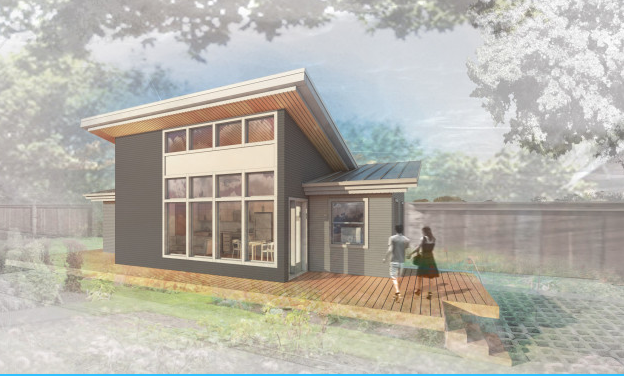|
Accessory Dwelling Units (ADUs) are a hot topic right now...and with good reason. ADUs can be one of the most cost effective and environmentally friendly ways for communities to expand their availability of affordable housing. So, what exactly is an ADU? The folks at Accessory Dwelling, an Oregon organization which helps people interested in ADUs, can explain that much better than I can: An accessory dwelling unit is a really simple and old idea: having a second small dwelling right on the same grounds (or attached to) your regular single-family house, such as:
Regardless of its physical form (backyard cottage, basement apartment, etc.), legally an ADU is part of the same property as the main home. It cannot be bought or sold separately, as a condominium or a dwelling on wheels might be. The owner of the ADU is the owner of the main home. Flexibility in housing makes sense for environmental, lifestyle, and financial reasons. Though many people buy houses and live in them for decades, their actual needs change over time. But the way that houses are currently built doesn’t reflect those changes, especially the way households may spend decades with just 1 or 2 members. Many American houses are too big for 1- or 2-person households, which is too bad, because size is probably the biggest single factor in the environmental impact of a house. If you have a reasonably sized house, and an even more reasonably sized ADU, you’ve likely got a pretty green combination with some social benefits as well. You could have your best friend, your mother, or your grown kid, live with you. This kind of flexibility and informal support could really help as the nation’s population ages. Most people want to stay in their homes as they age, but finances and design can be problematic. An ADU could help aging people meet their needs without moving. Additionally, ADUs create affordable housing, but not in the usual institutional way. The affordable housing ADUs create is unlike the product of the (subsidized) affordable housing industry. It is totally voluntary and un-guaranteed. For these reasons ADUs can never be the entire solution to the affordable housing challenge. On the other hand, ADUs are extremely economical to construct per unit, cost the government little or nothing to allow, and — given the number of single family residences in US cities — could be incredibly abundant. Perhaps best of all, ADUs are individualistic and creative. All impressions are that they add, in a small way, to family and neighborhood connections. They could be the opposite of boring gentrification — they might actually help make a place interesting enough to live in. HERE IS A WONDERFUL LITTLE VIDEO FROM ACCESSORY DWELLING.ORG ON ADUs. When it all said and done, the MWVHC thinks ADUs are a pretty great thing. In that regard, there is a bill currently in the New Hampshire legislature (Senate Bill146) concerning ADUs. The bills enjoys bipartisan support, has been passed by the NH Senate and is due for a House vote in early January. The Mount Washington Valley Housing Coalition joins many other organizations in strongly supporting the passage of SB146.
As written and amended, the bill addresses the growing need our state has to provide affordable housing opportunities for its citizens. In brief, the bill:
As outlined here, ADUs can represent a low cost, long-term way to help stem the rising tide of New Hampshire’s inadequate supply of affordable dwellings and workforce housing. ADUs:
Last year, the New Hampshire Housing Finance Authority commissioned a detailed, three-part study to examine factors that will influence New Hampshire’s future housing needs. The study was conducted by the New Hampshire Center for Public Policy Studies and Applied Economic Research. The resulting report recognized a serious gap between our existing housing stock and the needs and desires of our citizens. Passage of SB 146 represents a significant step toward addressing that mismatch and, at the same time, increasing our much needed supply of affordable housing. For all these reasons, we strongly urge you to support passage of Senate Bill 146.
4 Comments
Betsey Harding
12/21/2015 09:13:00 pm
Good work, Cole! Betsey
Reply
Leslie Mallett
12/21/2015 09:55:46 pm
I TOTALLY SUPPORT THIS!
Reply
Pat Wallace
3/25/2019 04:04:30 pm
I believe you developed an excellent video about accessory dwellings. I'm writing a brief article about them and would like to be able to direct readers to your site. Could you please send me the address. Thanks
Reply
Leave a Reply. |
Proudly powered by Weebly


 RSS Feed
RSS Feed